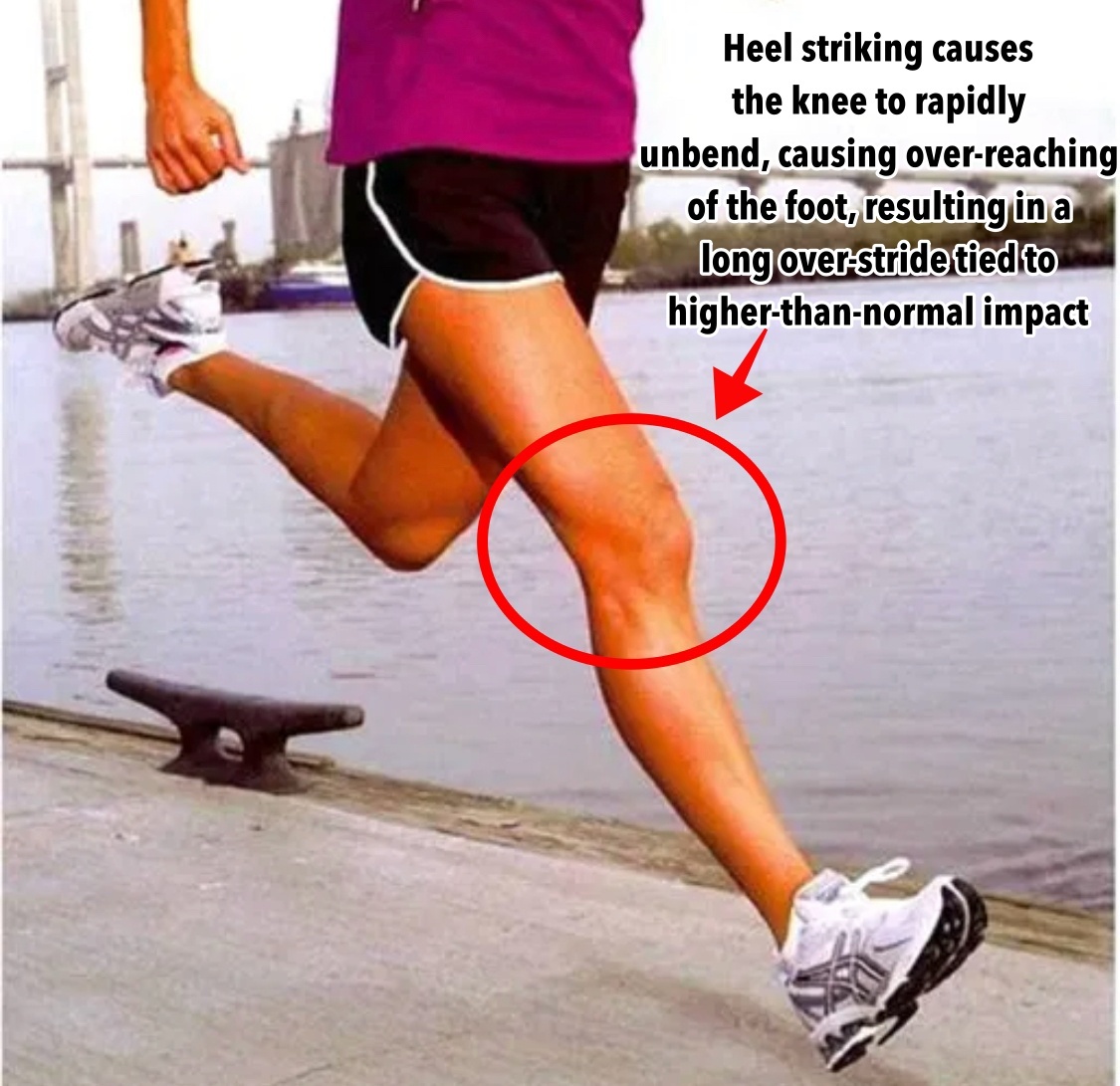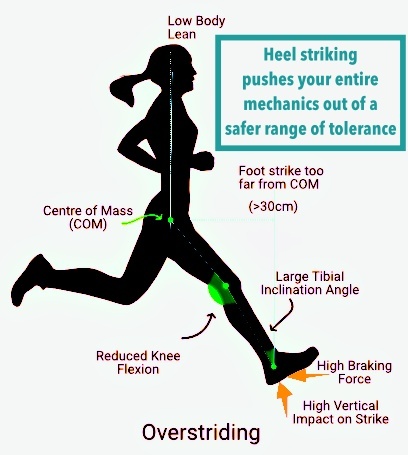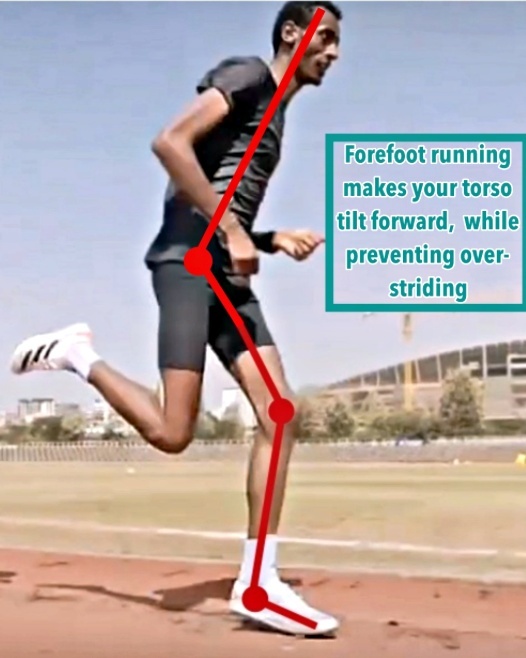Unfortunately, it’s inevitable that heel strike runners will encounter minor to severe knee injuries as accumulating data (references below article) demonstrates a strong link between chronic knee injury and heel strike running, and that knee injury can be fully prevented by switching to forefoot running!

Mounting evidence shows that maximum knee extension (fully unbent knee) at landing, coupled with the torso being pushed farther behind initial foot strike position are the natural by-products of heel strike running, which in turn, makes the knee increasingly vulnerable to injury.
- The farther back you land on your heel, threatens your biomechanics as a whole, because the swing leg reaches too far out in front of the body, which pushes the upper body too far back, which in turn, increases braking and compressive forces on the knee-joint by creating an unusually elongated stride, shown below:

Heel striking and over-striding co-occurs because of the maximum knee extension engaged by heel striking at touchdown. This increases angular work and mechanical stress at the knee, while increasing brake loads at touchdown, which makes the increasingly knee-joint vulnerable to injury.
- During braking, the mass of the body collides with the extended leg, creating excessive torque at the knee-joint
- Braking also produces a compression-wave that damages the knee.
- Vannatta and Kernozek (2015) found that a more extended knee at heel strike increased total stress on the patellofemoral joint over the course of stance during running.

Heel Striking Also Causes Tight Hamstrings Linked to Severe Knee Injury!
Another way heel strike running was found to cause knee injury is by causing tighter-than-normal hamstrings at landing:
- Goss and Gross (2012) maintained that hamstring tightness caused higher knee extension force production during running.
- They found that heel strike runners had greater quadricep force than forefoot runners, which exacerbated maximum knee extension and knee pain.
Why Forefoot Running is the ONLY Solution to Knee Pain
Traditionally, thick cushioned running shoes were considered a solution for knee injury, however to date, the evidence is overwhelming that thick cushioned running shoes causes the heel to plow harder down onto the ground in heel strike running, thereby producing more impact than not. This is something that is hard to come to terms with as we’ve been conditioned to believe that the thicker the underfoot cushioning, the safer we will run, but again, there’s just not enough evidence to support that. (You can read more on that here!)

The good news is, you can produce your own impact protection by switching to forefoot running, which has gained almost universal acclaim for doing the most good in safeguarding the knees, long-term. This is because angular work from the knee is significantly lower, while both the compressive wave and the burst in high braking impact produced in heel strike running is eliminated.
As shown above, at forefoot strike, instead of the knee completely unbending like it does in heel strike running, the knee flexes because it bends at landing, which helps dampen ground reaction forces (Goss and Gross 2012). Moreover, landing with a forefoot strike enhances other stride parameters, such as preventing an over-stride which increases step-rate, which automatically promotes less knee stress (Guiliani et al. 2011).
Therefore, learning forefoot running helps correct maladaptive landing behaviours and markedly reduces the destructive forces that directly causes knee-joint degeneration.
It’s for all these reasons that increasingly, runners are turning to forefoot running as it has led the way for not only preventing knee injury, but lower leg injury as well as back injuries! Read more here on that!

References:
Arendse RE, Noakes TD, Azevedo LB, Romanov N, Schwellnus MP, Fletcher G. Reduced eccentric
loading of the knee with the pose running method. Med Sci Sports Exerc. 2004;36(2):272-277.
Goss DL and Gross MT. A review of mechanics and injury trends among various running style. AMEDD, Sept -2012.
Giuliani J, Masini B, Alitz C, Owens BD. Bare- 38. foot-simulating footwear associated with metatarsal stress injury in 2 runners. Orthopedics. 2011;34(7):e320-323.
Messier et al. (2008). Risk factors and mechanisms of knee injury in runners.
Vannatta CN and Kernozek TW. Patellofemoral joint stress during running with alterations in foot strike pattern. Med Sci Sports Exerc, 2015;47(5):1001-1008.

Bretta Riches
BSc Neurobiology; MSc Biomechanics candidate, ultra minimalist runner & founder of RunForefoot. I was a heel striker, always injured. I was inspired by the great Tirunesh Dibaba to try forefoot running. Now, I'm injury free. This is why I launched Run Forefoot, to advocate the health & performance benefits of forefoot running and to raise awareness on the dangers of heel striking, because the world needs to know.
Latest posts by Bretta Riches (see all)
- Does Foot Strike Really Matter in Running? YES! - 17/04/2024
- Heel Lifts Increase Injury in Runners - 16/04/2024
- Are Minimalist Shoes Good for Seniors? YES! - 14/04/2024




